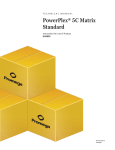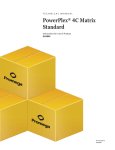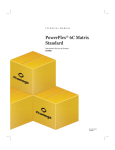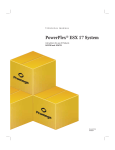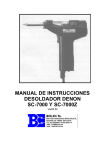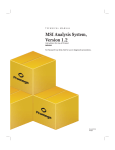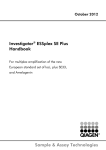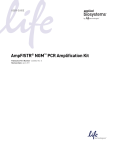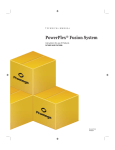Download PowerPlex® 5C Matrix Standards, 310
Transcript
TECHNICAL MANUAL PowerPlex® 5C Matrix Standards, 310 InstrucƟons for Use of Product DG5640 Printed 10/15 TMD050 PowerPlex® 5C Matrix Standards, 310 All technical literature is available at: www.promega.com/protocols/ Visit the web site to verify that you are using the most current version of this Technical Bulletin. E-mail Promega Technical Services if you have questions on use of this system:[email protected] 1. Description......................................................................................................................................... 1 2. Product Components and Storage Conditions ........................................................................................ 2 3. Detection of Matrix Fragments Using the ABI PRISM® 310 Genetic Analyzer, GeneMapper® ID or GeneMapper® ID-X Software, and POP-4® Polymer ................................................. 2 3.A. Instrument Preparation .............................................................................................................. 3 3.B. Matrix Sample Preparation ......................................................................................................... 3 3.C. Capillary Electrophoresis and Detection ....................................................................................... 4 3.D. Matrix Generation for the ABI PRISM® 310 Genetic Analyzer ........................................................ 4 4. Detection of Matrix Fragments Using the ABI PRISM® 310 Genetic Analyzer, GeneMapper® ID or GeneMapper® ID-X Software, and POP-6® Polymer ................................................. 6 4.A. Instrument Preparation .............................................................................................................. 7 4.B. Matrix Sample Preparation ......................................................................................................... 9 4.C. Capillary Electrophoresis and Detection ....................................................................................... 9 4.D. Matrix Generation for the ABI PRISM® 310 Genetic Analyzer ........................................................ 9 5. Troubleshooting................................................................................................................................ 10 6. Related Products ............................................................................................................................... 12 1. Description Proper generation of a matrix file is critical to evaluate multicolor STR data with the ABI PRISM® 310 Genetic Analyzer. To prepare a matrix, five standards are analyzed using the same capillary electrophoresis (CE) conditions that are used for samples and allelic ladders. The PowerPlex® 5-Dye Matrix Standards, 310(a), consists of DNA fragments labeled with five different fluorescent dyes. One tube contains DNA fragments labeled with fluorescein, one tube contains DNA fragments labeled with JOE, one tube contains DNA fragments labeled with TMR-ET, one tube contains DNA fragments labeled with CXR-ET, and one tube contains DNA fragments labeled with WEN. The PowerPlex® 5-Dye Matrix Standards, 310, can be used with any of the 5-dye Promega STR amplification systems. Use the Fluorescein Matrix, JOE Matrix, TMR-ET Matrix, CXR-ET Matrix and WEN Matrix for the blue, green, yellow, red and orange standards, respectively. A matrix must be generated for each individual instrument. A new matrix should be run after major maintenance on the system, such as changing the laser, calibrating or replacing the CCD camera or changing the polymer type or capillary array. We also recommend that you generate a new matrix after the instrument is moved to a new location. In some instances, a software upgrade may necessitate generation of a new matrix. Individual labs should determine the frequency of matrix generation. Protocols to operate the fluorescence-detection instrumentation should be obtained from the manufacturer. Promega CorporaƟon · 2800 Woods Hollow Road · Madison, WI 53711-5399 USA · Toll Free in USA 800-356-9526 · 608-274-4330 · Fax 608-277-2516 www.promega.com TMD050 · Printed 10/15 1 2. Product Components and Storage Conditions PRODUCT PowerPlex® 5C Matrix Standards, 310 SIZE C A T. # 50μl (each dye) DG5640 Not For Medical Diagnostic Use. Includes: • • • • • 50µl 50µl 50µl 50µl 50µl Fluorescein Matrix, 5-Dye (310) JOE Matrix, 5-Dye (310) TMR-ET Matrix, 5-Dye (310) CXR-ET Matrix, 5-Dye (310) WEN Matrix, 5-Dye (310) Storage Conditions: Upon receipt, store all components at –30°C to –10°C in a nonfrost-free freezer, protected from light. Do not store reagents in the freezer door, where the temperature can fluctuate. We strongly recommend that you store the PowerPlex® 5C Matrix Standard with the post-amplification reagents. The fragments in the matrix standards are light-sensitive and must be stored in the dark. ! Use these matrix standards once, and then discard them. Additional product information and ordering information for accessory components and related products are available upon request from Promega or at: www.promega.com 3. Detection of Matrix Fragments Using the ABI PRISM® 310 Genetic Analyzer, GeneMapper® ID or GeneMapper® ID-X Software, and POP-4® Polymer Materials to Be Supplied by the User • 95°C dry heating block, water bath or thermal cycler • crushed ice or ice-water bath • 310 capillaries, 47cm × 50µm • performance optimized polymer 4 (POP-4® polymer; see note below) • 10X genetic analyzer buffer • sample tubes and septa • aerosol-resistant pipette tips • Hi-Di™ formamide (Applied Biosystems Cat.# 4311320) ! ! The quality of formamide is critical. Use Hi-Di™ formamide. Freeze formamide in aliquots at –20°C. Multiple freeze-thaw cycles or long-term storage at 4°C can cause breakdown of formamide. Poor-quality formamide can contain ions that compete with DNA during injection, which results in lower peak heights and reduced sensitivity. A longer injection time may not increase the signal. Formamide is an irritant and a teratogen; avoid inhalation and contact with skin. Read the warning label, and take the necessary precautions when handling this substance. Always wear gloves and safety glasses when working with formamide. 2 Promega CorporaƟon · 2800 Woods Hollow Road · Madison, WI 53711-5399 USA · Toll Free in USA 800-356-9526 · 608-274-4330 · Fax 608-277-2516 TMD050 · Printed 10/15 www.promega.com Note: When using the PowerPlex® ESI 16 and 17 Pro Systems (Cat.# DC6770, DC6771, DC7780, DC7781) and PowerPlex® ESI 16 and 17 Fast Systems (Cat.# DC1620, DC1621, DC1720, DC1721), the use of performance optimized polymer 6 (POP-6®) might be necessary to resolve the 17.3 and 18 alleles and 18.3 and 19 alleles in the D12S391 allelic ladder and the 11.3 and 12 alleles in the D2S441 allelic ladder. See Section 4. 3.A. Instrument Preparation Refer to the ABI PRISM® 310 Genetic Analyzer User’s Manual for instructions on cleaning the pump block, installing the capillary, calibrating the autosampler and adding polymer to the syringe. 1. Open the ABI PRISM® 310 Data Collection Software, Version 3.1.0. 2. To preheat the ABI PRISM® 310 Genetic Analyzer to 60°C, select “Manual Control” in the Window menu. In the Function menu, select “Temperature Set”. Set Value to “60.0”, and then select “Execute”. Close the Manual Control screen. 3. In the File menu, select “New” to open the Create New menu. Open a GeneScan® sample sheet (either “48-Tube” or “96-Tube”). 4. In the upper right corner of the sample sheet, change “4 Dyes” to “5 Dyes”. Enter the appropriate sample information in the Sample Name field. Matrix sample names should be descriptive; for example, add the color to the sample name. Label tubes with the corresponding sample names. 5. To save the sample sheet, select “Save As” in the File menu. Assign a name to the file, and save to the Sample Sheet folder. Close the file. 6. In the File menu, select “New” to open the Create New menu. 7. Open the GeneScan® injection list. 8. Select the sample sheet (i.e., the .gss file) that was created in Step 5. 9. Choose the GS STR POP4 (1mL) G5v2.md5 module from the drop-down menu. The settings should be: Injection Time: 3 seconds Injection Voltage: 15.0kV Run Voltage: 15.0kV Run Temperature: 60°C Run Time: 28 minutes Note: The injection time may need to be increased or decreased, depending on instrument sensitivity. Peak heights of 1,000–4,000RFU are optimal for matrix generation. 10. Select “none” for the matrix file. 3.B. Matrix Sample Preparation 1. Thaw the matrix standards on ice. For each matrix standard, vortex the tube for 5–10 seconds to mix, and then add 2µl of matrix standard to 25µl of Hi-Di™ formamide. 2. Denature each sample for 3 minutes at 95°C, and immediately chill on crushed ice or in an ice-water bath for 3 minutes. Denature samples just prior to loading. 3. Place tubes in the appropriate autosampler tray (48-tube or 96-well). 4. Place the autosampler tray in the instrument, and close the instrument doors. Promega CorporaƟon · 2800 Woods Hollow Road · Madison, WI 53711-5399 USA · Toll Free in USA 800-356-9526 · 608-274-4330 · Fax 608-277-2516 www.promega.com TMD050 · Printed 10/15 3 3.C. Capillary Electrophoresis and Detection 1. After loading the sample tray and closing the doors, select “Run” to start the capillary electrophoresis system. 2. Monitor the electrophoresis by observing the raw data and status windows. Each sample will take approximately 40 minutes for syringe pumping, sample injection and electrophoresis. Note: The matrix files that are created will be .fsa files. After the run is finished, save or transfer the .fsa files to a secure location where they can be opened in a GeneMapper® project. 3.D. Matrix Generation for the ABI PRISM® 310 Genetic Analyzer Open a new GeneMapper® project. To add matrix sample files to the new project, select “Add Samples to Project” in the File menu for GeneMapper® ID software or the Edit menu for GeneMapper® ID-X software. Choose the appropriate run folder containing the .fsa files from Section 3.C. Highlight the run folder, and select “Add To List” then “Add”. 2. To open the raw data for a specific matrix sample file, locate “Project” in the upper left corner of the screen, and double-click on the run folder to reveal the .fsa files. 3. Choose a single .fsa file to observe the raw data. While viewing the raw data, move the cursor to the region that is to the right of the primer peak and to the left of at least five peaks. Choose a region in a flat part of the baseline. An example of WEN raw data is shown in Figure 1. 13301TA 1. Figure 1. WEN Matrix raw data. The WEN Matrix standard was analyzed using an ABI PRISM® 310 Genetic Analyzer and POP-4® polymer. GeneMapper® ID software was used to view the raw data. 4 Promega CorporaƟon · 2800 Woods Hollow Road · Madison, WI 53711-5399 USA · Toll Free in USA 800-356-9526 · 608-274-4330 · Fax 608-277-2516 TMD050 · Printed 10/15 www.promega.com 4. Record the data point value found at the lower left portion of the screen for use in Step 6. Repeat this step for each matrix standard. Dye Color Corresponding Matrix Blue Fluorescein Matrix Green JOE Matrix Yellow TMR-ET Matrix Red CXR-ET Matrix Orange WEN Matrix “Start At” Value 5. To create a new matrix, select “GeneMapper Manager” in the Tools menu. Select the Matrices tab and then “New”. 6. Define the new matrix in the Matrix Editor (Figure 2). Note: The Matrix Name, “Start At” values and Matrix Result values shown in Figure 2 are instrument-specific and will change depending on your instrument and whether you are using POP-4® or POP-6® polymer. a. Assign a matrix name in the Matrix Name field. b. Set Number of Dyes to “5”. c. To select each matrix standard sample file, click on the dye color for each matrix (B for fluorescein, G for JOE, Y for TMR-ET, R for CXR-ET and O for WEN). Navigate to the .fsa sample file that corresponds to that dye, and double-click on it to add the sample file. Repeat this step for each matrix standard. Note: To find the .fsa files in the default location, go to: “My Computer”, “AB SW8DATA (D:)“, “Applied Bio”, “310” and then “Runs”, and locate the correct run folder. d. Enter the data point value recorded from Step 4 in the “Start at” field. Repeat this step for each matrix standard. e. Click on the Create button. The Matrix Result should give a value of 1.000 when comparing a dye to itself. Typically, all other values will be less than 1.000 except for the value indicated in red in Figure 2. Select “OK”, and the matrix will be created in the Matrices tab of the GeneMapper® Manager. Select “Done”. Promega CorporaƟon · 2800 Woods Hollow Road · Madison, WI 53711-5399 USA · Toll Free in USA 800-356-9526 · 608-274-4330 · Fax 608-277-2516 www.promega.com TMD050 · Printed 10/15 5 13300TA Figure 2. The Matrix Editor. 4. Detection of Matrix Fragments Using the ABI PRISM® 310 Genetic Analyzer, GeneMapper® ID or GeneMapper® ID-X Software, and POP-6® Polymer Materials to Be Supplied by the User • 95°C dry heating block, water bath or thermal cycler • crushed ice or ice-water bath • 310 capillaries, 47cm × 50µm • performance optimized polymer 6 (POP-6® polymer; see note below) • 10X genetic analyzer buffer • sample tubes and septa • aerosol-resistant pipette tips • Hi-Di™ formamide (Applied Biosystems Cat.# 4311320) ! ! The quality of formamide is critical. Use Hi-Di™ formamide. Freeze formamide in aliquots at –20°C. Multiple freeze-thaw cycles or long-term storage at 4°C can cause breakdown of formamide. Poor-quality formamide can contain ions that compete with DNA during injection, which results in lower peak heights and reduced sensitivity. A longer injection time may not increase the signal. Formamide is an irritant and a teratogen; avoid inhalation and contact with skin. Read the warning label, and take the necessary precautions when handling this substance. Always wear gloves and safety glasses when working with formamide. 6 Promega CorporaƟon · 2800 Woods Hollow Road · Madison, WI 53711-5399 USA · Toll Free in USA 800-356-9526 · 608-274-4330 · Fax 608-277-2516 TMD050 · Printed 10/15 www.promega.com Note: When using the PowerPlex® ESI 16 and 17 Pro Systems (Cat.# DC6770, DC6771, DC7780, DC7781) and PowerPlex® ESI 16 and 17 Fast Systems (Cat.# DC1620, DC1621, DC1720, DC1721), the use of POP-6® polymer might be necessary to resolve the 17.3 and 18 alleles and 18.3 and 19 alleles in the D12S391 allelic ladder and the 11.3 and 12 alleles in the D2S441 allelic ladder. 4.A. Instrument Preparation Refer to the ABI PRISM® 310 Genetic Analyzer User’s Manual for instructions on cleaning the pump block, installing the capillary, calibrating the autosampler and adding polymer to the syringe. Open the ABI PRISM® 310 Data Collection Software, Version 3.1.0. 2. To preheat the ABI PRISM® 310 Genetic Analyzer to 60°C, select “Manual Control” in the Window menu. In the Function menu, select “Temperature Set”. Set Value to “60.0”, and then select “Execute”. 3. It is necessary to create a module for use with POP-6® polymer at the first use. This module can be saved and used for subsequent runs. To make and save a module for use with POP-6® polymer, choose the GS STR POP4 (1mL) G5v2.md5 module using the drop-down menu under “Module”. 4. Click on the folded page icon (Figure 3). 9103TA 1. Figure 3. The Manual Control screen. Change the Collection Time to “50” and Syringe Pump Time to “360” (Figure 4). Select “Save Copy In”. 9104TA 5. Figure 4. Changing the collection time and syringe pump time. Promega CorporaƟon · 2800 Woods Hollow Road · Madison, WI 53711-5399 USA · Toll Free in USA 800-356-9526 · 608-274-4330 · Fax 608-277-2516 www.promega.com TMD050 · Printed 10/15 7 4.A. Instrument Preparation (continued) Save the new module in the Modules folder. Change the file name to “GS STR POP6 (1mL) G5v2.md5”, and select “Save” (Figure 5). 9105TA 6. Figure 5. The Save screen. 7. In the File menu, select “New” to open the Create New menu. Open a GeneScan® sample sheet (either “48-Tube” or “96-Tube”). 8. In the upper right corner of the sample sheet, change “4 Dyes” to “5 Dyes”. Enter the appropriate sample information in the Sample Name field. Matrix sample names should be descriptive; for example, add the color to the sample name. Label tubes with the corresponding sample names. 9. To save the sample sheet, select “Save As” in the File menu. Assign a name to the file, and save to the Sample Sheet folder. Close the file. 10. In the File menu, select “New” to open the Create New menu. 11. Open the GeneScan® injection list. 12. Select the sample sheet (i.e., the .gss file) that was created in Step 9. 13. Choose the GS STR POP6 (1mL) G5v2.md5 module created in Step 6 using the drop-down menu. The settings should be: Injection Time: 3 seconds Injection Voltage: 15.0kV Run Voltage: 15.0kV Run Temperature: Run Time: 60°C 50 minutes Note: The injection time may need to be increased or decreased, depending on instrument sensitivity. Peak heights of 1,000–4,000RFU are optimal for matrix generation. 14. 8 Select “none” for the matrix file. Promega CorporaƟon · 2800 Woods Hollow Road · Madison, WI 53711-5399 USA · Toll Free in USA 800-356-9526 · 608-274-4330 · Fax 608-277-2516 TMD050 · Printed 10/15 www.promega.com 4.B. Matrix Sample Preparation 1. Thaw the matrix standards. For each matrix standard, vortex the tube for 5–10 seconds to mix, and then add 2µl of matrix standard to 25µl of Hi-Di™ formamide. 2. Denature each sample for 3 minutes at 95°C, and immediately chill on crushed ice or in an ice-water bath for 3 minutes. Denature samples just prior to loading. 3. Place tubes in the appropriate autosampler tray (48-tube or 96-tube). 4. Place the autosampler tray in the instrument, and close the instrument doors. 4.C. Capillary Electrophoresis and Detection 1. After loading the sample tray and closing the doors, select “Run” to start the capillary electrophoresis system. 2. Monitor the electrophoresis by observing the raw data and status windows. Each sample will take approximately 60 minutes for syringe pumping, sample injection and electrophoresis. Note: The matrix files that are created will be .fsa files. After the run is finished, save or transfer the .fsa files to a secure location where they can be opened in a GeneMapper® project. 4.D. Matrix Generation for the ABI PRISM® 310 Genetic Analyzer 1. Open a new GeneMapper® project. To add matrix sample files to the new project, select “Add Samples to Project” in the File menu for GeneMapper® ID software or the Edit menu for GeneMapper® ID-X software. Choose the appropriate run folder containing the .fsa files from Section 4.C. Highlight the run folder, and select “Add To List” and then “Add”. 2. To open the raw data for a specific matrix sample file, locate “Project” in the upper left corner of the screen, and double-click on the run folder to reveal the .fsa files. 3. Choose a single .fsa file to observe the raw data. While reviewing the raw data, move the cursor to the region that is to the right of the primer peak and to the left of at least five peaks. Choose a region in the flat part of the baseline. 4. Record the data point value found at the lower left portion of the screen for use in Step 6. Repeat this step for each matrix standard. 5. Dye Color Corresponding Matrix Blue Fluorescein Matrix Green JOE Matrix Yellow TMR-ET Matrix Red CXR-ET Matrix Orange WEN Matrix “Start At” Value To create a new matrix, select “GeneMapper Manager” in the Tools menu. Select the Matrices tab and then “New”. Promega CorporaƟon · 2800 Woods Hollow Road · Madison, WI 53711-5399 USA · Toll Free in USA 800-356-9526 · 608-274-4330 · Fax 608-277-2516 www.promega.com TMD050 · Printed 10/15 9 4.D. Matrix Generation for the ABI PRISM® 310 Genetic Analyzer (continued) 6. Define the new matrix in the Matrix Editor (Figure 2). Note: The Matrix Name, “Start At” values and Matrix Result values shown in Figure 2 are instrument-specific and will change depending on your instrument and whether you are using POP-4® or POP-6® polymer. a. Assign a matrix name in the Matrix Name field. b. Set Number of Dyes to “5”. c. To select each matrix standard sample file, click on the dye color for each matrix (B for fluorescein, G for JOE, Y for TMR-ET, R for CXR-ET and O for WEN). Navigate to the .fsa sample file that corresponds to that dye, and double-click on it to add the sample file. Repeat this step for each matrix standard. Note: To find the .fsa files in the default location, go to: “My Computer”, “AB SW8DATA (D:)“, “Applied Bio”, “310” and then “Runs”, and locate the correct run folder. d. Enter the data point value recorded from Step 4 in the “Start at” field. Repeat this step for each matrix standard. e. Click on the Create button. The Matrix Result should give a value of 1.000 when comparing a dye to itself. Typically, all other values will be less than 1.000 except for the value indicated in red in Figure 2. Select “OK”, and the matrix will be created in the Matrices tab of the GeneMapper® Manager. Select “Done”. 5. Troubleshooting For questions not addressed here, please contact your local Promega Branch Office or Distributor. Contact information available at: www.promega.com. E-mail: [email protected] Symptoms Unable to generate a matrix due to faint or no peaks Causes and Comments Peak heights were too low. Peak heights should be 1,000–4,000RFU for the ABI PRISM® 310 Genetic Analyzer. To increase peak heights, increase the injection time or loading volume. Poor capillary electrophoresis (CE) injection. Re-inject the sample. Check the syringe for leakage. Check the laser power. Poor-quality formamide was used. Use only fresh Hi-Di™ formamide. Samples were degraded due to improper storage. Store matrix standards at –30°C to –10°C, protected from light. Do not store in the freezer door or in a frost-free freezer. We recommend using these matrix standards once and then discarding them. Samples were not denatured. Heat-denature samples, and immediately chill on crushed ice or in an ice-water bath before loading the capillary. Denature samples just prior to loading. 10 Promega CorporaƟon · 2800 Woods Hollow Road · Madison, WI 53711-5399 USA · Toll Free in USA 800-356-9526 · 608-274-4330 · Fax 608-277-2516 TMD050 · Printed 10/15 www.promega.com Symptoms Peak heights too high Causes and Comments Peak heights were above 4,000RFU. To decrease peak heights, decrease the injection time or loading volume. Poor-quality matrix (extra peaks visible in one or all of the color channels) CE-related artifacts (“spikes”). Minor voltage changes or urea crystals passing by the laser can cause “spikes” or unexpected peaks. Spikes sometimes appear in one color but often are easily identified by their presence in more than one color. Re-inject the samples to confirm. CE-related artifacts (contaminants). Contaminants in the water used with the ABI PRISM® 310 Genetic Analyzer and for diluting the 10X genetic analyzer buffer can generate peaks in the fluorescein and JOE dye channels. Use autoclaved water to clean the pump block and prepare sample dilutions. Change vials, and wash the buffer reservoir. Extra peaks in the CXR-ET dye channels Extra peaks may appear in the CXR-ET dye channels but do not affect matrix quality. Poor-quality matrix (elevated baseline and/or inverted peaks in analyzed samples) Matrix used was generated on another instrument. A matrix must be generated for each instrument. Wrong dye was used. Generate the matrix using the same dyes as those in the samples. Oversubtraction of signal occurred because signal was saturated. When generating a matrix, avoid choosing samples with peak heights that are higher than the recommended RFU values, as this can result in a matrix that causes inverted peaks or elevated baseline. Analyzed sample results may be improved by diluting matrix samples in water before preparing them for use. Alternatively, decrease the injection time. Inverted peaks in matrix baseline Inappropriate or no “Start At” value was entered. The “Start At” value entered in Sections 3.D or 4.D should be chosen in a region with a flat baseline. Wrong colors were assigned to the dyes. Confirm the dye and color selection: Fluorescein: Blue JOE: Green TMR-ET: Yellow CXR-ET: Red WEN Orange Promega CorporaƟon · 2800 Woods Hollow Road · Madison, WI 53711-5399 USA · Toll Free in USA 800-356-9526 · 608-274-4330 · Fax 608-277-2516 www.promega.com TMD050 · Printed 10/15 11 5. Troubleshooting (continued) Symptoms Previously generated matrix no longer performs optimally 6. Causes and Comments Changes to or aging of instrument components. Instrument sensitivity can change if the instrument is moved or recently serviced (replacement or realignment of the laser, CCD camera, power supply or mirrors). The sensitivity also can change over time due to aging of the instrument. These changes can result in poor matrix performance. Generate a new matrix. Related Products Product ® PowerPlex Fusion System ® PowerPlex Y23 System ® PowerPlex 21 System ® PowerPlex 18D System ® PowerPlex ESX 16 Fast System ® PowerPlex ESX 17 Fast System ® PowerPlex ESI 16 Fast System ® PowerPlex ESI 17 Fast System ® PowerPlex ESX 16 System ® PowerPlex ESX 17 System ® PowerPlex ESI 16 System ® PowerPlex ESI 17 Pro System Size Cat.# 200 reactions DC2402 800 reactions DC2408 50 reactions DC2305 200 reactions DC2320 200 reactions DC8902 4 × 200 reactions DC8942 200 reactions DC1802 800 reactions DC1808 100 reactions DC1611 400 reactions DC1610 100 reactions DC1711 400 reactions DC1710 100 reactions DC1621 400 reactions DC1620 100 reactions DC1721 400 reactions DC1720 100 reactions DC6711 400 reactions DC6710 100 reactions DC6721 400 reactions DC6720 100 reactions DC6771 400 reactions DC6770 100 reactions DC7781 400 reactions DC7780 Not for Medical Diagnostic Use. 12 Promega CorporaƟon · 2800 Woods Hollow Road · Madison, WI 53711-5399 USA · Toll Free in USA 800-356-9526 · 608-274-4330 · Fax 608-277-2516 TMD050 · Printed 10/15 www.promega.com (a) TMR-ET, CXR-ET and WEN dyes are proprietary. © 2015 Promega CorporaƟon. All Rights Reserved. PowerPlex is a registered trademark of Promega CorporaƟon. ABI PRISM and GeneMapper are registered trademarks of Applied Biosystems. GeneScan is a registered trademark of Eurofins Genescan Holding GmbH. Hi-Di is a trademark of Applera CorporaƟon. POP-4 and POP-6 are registered trademarks of Life Technologies CorporaƟon. Products may be covered by pending or issued patents or may have certain limitaƟons. Please visit our Web site for more informaƟon. All prices and specificaƟons are subject to change without prior noƟce. Product claims are subject to change. Please contact Promega Technical Services or access the Promega online catalog for the most up-to-date informaƟon on Promega products. Promega CorporaƟon · 2800 Woods Hollow Road · Madison, WI 53711-5399 USA · Toll Free in USA 800-356-9526 · 608-274-4330 · Fax 608-277-2516 www.promega.com TMD050 · Printed 10/15 13














